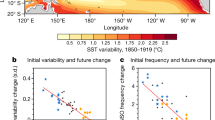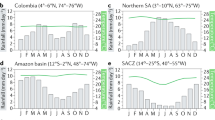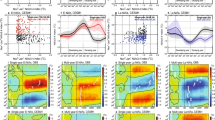Abstract
The El Niño/Southern Oscillation (ENSO) represents the most consequential fluctuation of the global climate system, with dramatic societal and environmental impacts. Its general dynamics are reasonably well understood in terms of ocean–atmosphere interactions that modify the Walker circulation in the equatorial Pacific. However, some of its space–time features remain stubbornly elusive, such as its event-to-event diversity and asymmetry. Here we show that zonal shifts in the Walker circulation control ENSO space–time complexity in a low-dimensional theoretical framework. We encapsulate these movements in a conventional recharge–discharge oscillator for ENSO by replacing the regionally fixed sea surface temperature index with a warm-pool edge index that displaces the Walker circulation structures. By doing so, we can model essential ingredients of ENSO diversity and nonlinear behaviour without increasing the complexity of the dynamical model. The simple framework is able to reproduce the continuum of ENSO flavours and the asymmetry in the amplitude of warm and cold events. The spatial shifting concept paves the way for a more unified understanding of ENSO and its associated climate teleconnections.
This is a preview of subscription content, access via your institution
Access options
Access Nature and 54 other Nature Portfolio journals
Get Nature+, our best-value online-access subscription
$29.99 / 30 days
cancel any time
Subscribe to this journal
Receive 12 print issues and online access
$259.00 per year
only $21.58 per issue
Buy this article
- Purchase on Springer Link
- Instant access to full article PDF
Prices may be subject to local taxes which are calculated during checkout




Similar content being viewed by others
Data availability
GODAS47 data and OLR48 data are provided by the National Oceanic and Atmospheric Administration Physical Sciences Laboratory, Boulder, Colorado, USA, from the website https://psl.noaa.gov. CESM-LE49 data are provided by National Science Foundation/Computational and Information Systems Lab/Yellowstone from the website https://www.earthsystemgrid.org/dataset/ucar.cgd.ccsm4.cesmLE.html.
Code availability
The code associated with this paper is available upon request from the corresponding author.
References
Ropelewski, C. F. & Halpert, M. S. Global and regional scale precipitation patterns associated with the El Niño Southern Oscillation. Mon. Weather Rev. 115, 1606–1626 (1987).
McPhaden, M. J., Zebiak, S. E. & Glantz, M. H. ENSO as an integrating concept in Earth science. Science 314, 1740–1745 (2006).
Kug, J.-S., Jin, F.-F. & An, S.-I. Two types of El Niño events: cold tongue El Niño and warm pool El Niño. J. Clim. 22, 1499–1515 (2009).
Kao, H.-Y. & Yu, J.-Y. Contrasting eastern-Pacific and central-Pacific types of ENSO. J. Clim. 22, 615–632 (2009).
Barnston, A. G., Tippett, M. K., L’Heureux, M. L., Li, S. & DeWitt, D. G. Skill of real-time seasonal ENSO model predictions during 2002–11: is our capability increasing? Bull. Am. Meteorol. Soc. 93, 631–651 (2012).
Bellenger, H., Guilyardi, E., Leloup, J., Lengaigne, M. & Vialard, J. ENSO representation in climate models: from CMIP3 to CMIP5. Clim. Dyn. 42, 1999–2018 (2014).
Ham, Y.-G. & Kug, J.-S. How well do current climate models simulate two types of El Niño? Clim. Dyn. 39, 383–398 (2012).
Neelin, J. D. et al. ENSO theory. J. Geophys. Res. 103, 14261–14290 (1998).
Jin, F.-F. et al. in El Niño Southern Oscillation in a Changing Climate Vol. 253 (eds McPhaden, M.J. et al.) 119–151 (AGU, 2020).
Guilyardi, E., Capotondi, A., Lengaigne, M., Thual, S. & Wittenberg, A.T. in El Niño Southern Oscillation in a Changing Climate Vol. 253 (eds McPhaden, M.J. et al.) 199–226 (AGU, 2020)
Capotondi, A., Wittenberg, A., Kug, J.-S., Takahashi, K. & McPhaden, M.J. in El Niño Southern Oscillation in a Changing Climate Vol. 253 (eds McPhaden, M.J. et al.) 65–86 (AGU, 2020).
Frauen, C. & Dommenget, D. El Niño and La Niña amplitude asymmetry caused by atmospheric feedbacks. Geophys. Res. Lett. 37, L18801 (2010).
Xie, R. & Jin, F.-F. Two leading ENSO modes and El Niño types in the Zebiak–Cane model. J. Clim. 31, 1943–1962 (2018).
Hu, S. & Fedorov, A. V. Cross-equatorial winds control El Niño diversity and change. Nat. Clim. Change 8, 798–802 (2018).
Capotondi, A. & Sardeshmukh, P. D. Optimal precursors of different types of ENSO events. Geophys. Res. Lett. 42, 9952–9960 (2015).
An, S.-I., Tziperman, E., Okumura, Y.M. & Li, T. in El Niño Southern Oscillation in a Changing Climate Vol. 253 (eds McPhaden, M.J. et al.) 153–172 (AGU, 2020).
Timmermann, A., Jin, F.-F. & Abshagen, J. A nonlinear theory for El Niño bursting. J. Atmos. Sci. 60, 152–165 (2003).
An, S.-I. & Jin, F.-F. Nonlinearity and asymmetry of ENSO. J. Clim. 17, 2399–2412 (2004).
Timmermann, A. et al. El Niño–Southern Oscillation complexity. Nature 559, 535–545 (2018).
Jin, F.-F. An equatorial ocean recharge paradigm for ENSO. Part I: conceptual model. J. Atmos. Sci. 54, 811–829 (1997).
Bjerknes, J. Atmospheric teleconnections from the equatorial Pacific. Mon. Weather Rev. 97, 163–172 (1969).
Dijkstra, H. A. & Neelin, J. D. Ocean–atmosphere interaction and the tropical climatology. Part II: why the Pacific cold tongue is in the east. J. Clim. 8, 1343–1359 (1995).
Xie, S.-P. Ocean–atmosphere interaction in the making of the Walker circulation and equatorial cold tongue. J. Clim. 11, 189–201 (1998).
Schopf, P. S. & Burgman, R. J. A simple mechanism for ENSO residuals and asymmetry. J. Clim. 19, 3167–3179 (2006).
Picaut, J., Masia, F. & du Penhoat, Y. An advective–reflective conceptual model for the oscillatory nature of the ENSO. Science 277, 663–666 (1997).
Clarke, A. J., Wang, J. & Van Gorder, S. A simple warm-pool displacement ENSO model. J. Phys. Oceanogr. 30, 1679–1691 (2000).
Meinen, C. S. & McPhaden, M. J. Observations of warm water volume changes in the equatorial Pacific and their relationship to El Niño and La Niña. J. Clim. 13, 3551–3559 (2000).
Vecchi, G. A. & Harrison, D. Tropical pacific sea surface temperature anomalies, El Niño, and equatorial westerly wind events. J. Clim. 13, 1814–1830 (2000).
Jin, F.-F., Lin, L., Timmermann, A. & Zhao, J. Ensemble-mean dynamics of the ENSO recharge oscillator under state-dependent stochastic forcing. Geophys. Res. Lett. 34, L03807 (2007).
Takahashi, K., Karamperidou, C. & Dewitte, B. A theoretical model of strong and moderate El Niño regimes. Clim. Dyn. 52, 7477–7493 (2019).
Chen, N., Fang, X. & Yu, J.-Y. A multiscale model for El Niño complexity. npj Clim. Atmos. Sci. 5, 16 (2022).
Jin, F.-F., Kim, S.T. & Bejarano, L. A coupled-stability index for ENSO. Geophys. Res. Lett. 33, L23708 (2006).
Takahashi, K., Montecinos, A., Goubanova, K. & Dewitte, B. ENSO regimes: reinterpreting the canonical and Modoki El Niño. Geophys. Res. Lett. 38, L10704 (2011).
Dommenget, D., Bayr, T. & Frauen, C. Analysis of the non-linearity in the pattern and time evolution of El Niño Southern Oscillation. Clim. Dyn. 40, 2825–2847 (2013).
Karamperidou, C., Jin, F.-F. & Conroy, J. L. The importance of ENSO nonlinearities in tropical Pacific response to external forcing. Clim. Dyn. 49, 2695–2704 (2017).
Cai, W. et al. Increased variability of eastern Pacific El Niño under greenhouse warming. Nature 564, 201–206 (2018).
Williams, I. N. & Patricola, C. M. Diversity of ENSO events unified by convective threshold sea surface temperature: a nonlinear ENSO index. Geophys. Res. Lett. 45, 9236–9244 (2018).
Stuecker, M. F., Timmermann, A., Jin, F.-F., McGregor, S. & Ren, H.-L. A combination mode of the annual cycle and the El Niño Southern Oscillation. Nat. Geosci. 6, 540–544 (2013).
Martinez-Villalobos, C. & Vimont, D. J. An analytical framework for understanding tropical meridional modes. J. Clim. 30, 3303–3323 (2017).
Cai, W. et al. Pantropical climate interactions. Science 363, 4236 (2019).
Yun, K.-S., Timmermann, A. & Stuecker, M. F. Synchronized spatial shifts of Hadley and Walker circulations. Earth Syst. Dynam. 12, 121–132 (2021).
Klein, S. A., Soden, B. J. & Lau, N.-C. Remote sea surface temperature variations during ENSO: evidence for a tropical atmospheric bridge. J. Clim. 12, 917–932 (1999).
Vijayeta, A. & Dommenget, D. An evaluation of ENSO dynamics in CMIP simulations in the framework of the recharge oscillator model. Clim. Dyn. 51, 1753–1771 (2018).
Fedorov, A.V., Hu, S., Wittenberg, A.T., Levine, A.F.Z. & Deser, C. in El Niño Southern Oscillation in a Changing Climate Vol. 253 (eds McPhaden, M.J. et al.) 173–198 (AGU, 2020).
Fedorov, A. V. & Philander, S. G. A stability analysis of tropical ocean–atmosphere interactions: bridging measurements and theory for El Niño. J. Clim. 14, 3086–3101 (2001).
Wittenberg, A.T. Are historical records sufficient to constrain ENSO simulations?. Geophys. Res. Lett. 36, L12702 (2009).
Behringer, D. & Xue, Y. Evaluation of the global ocean data assimilation system at NCEP: the Pacific Ocean. In Proc. 8th Symposium on Integrated Observing and Assimilation Systems for Atmosphere, Oceans, and Land Surface, 11–15 (AMS, 2004).
Liebmann, B. & Smith, C. A. Description of a complete (interpolated) outgoing longwave radiation dataset. Bull. Am. Meteorol. Soc. 77, 1275–1277 (1996).
Kay, J. E. et al. The Community Earth System Model (CESM) large ensemble project: a community resource for studying climate change in the presence of internal climate variability. Bull. Am. Meteorol. Soc. 96, 1333–1349 (2015).
Deser, C. et al. ENSO and Pacific decadal variability in the Community Climate System Model version 4. J.Clim 25, 2622–2651 (2012).
Acknowledgements
The research of S.T. is supported by Agence Nationale de la Recherche (grant ANR-18-CE01-0012). B.D. acknowledges support from Agencia Nacional de Investigación y Desarrollo (Concurso de Fortalecimiento al Desarrollo Científico de Centros Regionales 2020-R20F0008-CEAZA, Anillo Eclipse ACT210071, Núcleo Milenio UPWELL NCN19-153, Centro de Investigación Oceanográfica en el Pacífico Sur-Oriental COASTAL FB210021) and Agence Nationale de la Recherche (grant ANR-18-CE01-0012). We thank G. Bellon and O. Thual for discussions.
Author information
Authors and Affiliations
Contributions
S.T. designed and performed the research. S.T. and B.D. discussed the research and wrote the paper.
Corresponding author
Ethics declarations
Competing interests
The authors declare no competing interests.
Peer review
Peer review information
Nature Geoscience thanks Fei-Fei Jin and the other, anonymous, reviewer(s) for their contribution to the peer review of this work. Primary Handling Editor: Tom Richardson, in collaboration with the Nature Geoscience team.
Additional information
Publisher’s note Springer Nature remains neutral with regard to jurisdictional claims in published maps and institutional affiliations.
Extended data
Extended Data Fig. 1 Idealized Walker circulation structure.
Zonal profiles of zonal wind stresses (ZWS, a), sea surface temperatures (SST, b) and thermocline depth (TD, c) in a longitudinal strip spanning the equatorial Pacific (black lines and fillings). The circulation can vary in terms of its warm pool extent χ, and thermocline depth can additionally vary in terms of its basin-wide average hM (blue dashed lines). We adjust these variables in the figure in order to match observed temporal averages of ZWS, SST and TD (purple dashed lines). Observed temporal average of outgoing longwave radiations (OLR) is displayed in (a) as an indicator of convective heating over the warm pool that drives the atmospheric part of the circulation.
Extended Data Fig. 2 Time-longitude hovmollers for totals.
a,b,c,d, Time-longitude hovmollers of outgoing longwave radiation (OLR), zonal wind stress (ZWS), sea surface temperature (SST) and thermocline depth (TD) in the equatorial Pacific, as computed from observations (averaged 5∘N-5∘S with seasonal variations removed). e,f,g, Analysis repeated for the outputs of the oscillator model (which excludes OLR), displayed over a hand-picked period. Solid lines in each panel indicate the longitudinal position of the warm pool edge (that is, 29∘C SST isotherm, see methods). The spatial shifting of the Walker circulation consists of a general and coherent longitudinal movement of the atmospheric and oceanic structures that follows the warm pool edge. The movement is less apparent on thermocline depth (panels d,g) that also varies substantially in terms of its basin-wide average.
Extended Data Fig. 3 Phase space evolution.
a,b, Timeseries of warm pool extent χ and basin-wide heat content hM obtained from a numerical integration of the oscillator model (Eq. (1)), and which represents ENSO variability. Warm pool extent χ within 0-1 corresponds to a warm pool edge position within 120∘E-80∘W. Shading indicates the hand-picked period used in other figures. c,d, Kernel density estimates (filled contours) and individual realizations (black lines) in phase space of warm pool extent χ and basin-wide heat content hM, compared between observations and model solutions. For clarity, density estimates are shown only above 0.04% where they hide individual realizations that are too dense to visualize. Phase space is divided into El Niño or La Niña states as well as recharged or discharged states as defined here with respect to average conditions (white dashed lines). El Niño events may reach larger amplitudes than La Niña events but are more short-lived.
Extended Data Fig. 4 ENSO cycle in the oscillator model.
a-d, Sketch of the Walker circulation at the four consecutive stages of one ENSO cycle: contracted (La Niña), recharged, expanded (El Niño) and discharged. This is shown for sea surface temperatures (SST) and thermocline depth (TD) represented as in Extended Data Fig. 1. The circulation is entirely determined by the warm pool extent χ that shifts the structures and the basin-wide heat content hM that sets the zonal mean TD, as indicated at each stage of the cycle (blue dashed lines) and for the entire cycle (red lines, years 132 to 135 in Fig. 1)). e-h, Mean state of SST and TD (that is temporal averages computed over the entire simulation, green dashed lines) with total fields from a-d repeated (gray fillings). i-l, Sea surface temperature anomalies (SSTA) and thermocline depth anomalies (TDA) at each stage as computed with respect to the mean state.
Extended Data Fig. 5 Indices timeseries.
a-d, Timeseries from observations of warm pool edge position (WPE, a), SST spatial averages (b), thermocline depth spatial averages (c), and Niño SST indices (d). e-h, Analysis repeated for outputs of the oscillator model displayed over a hand-picked period. We also show ad-hoc stochastic forcing ζ in the oscillator model (e, green line). The indices TW, TE, TM average SST conditions respectively over the warm pool (120∘E-WPE), cold tongue (WPE-80∘W) and entire basin (120∘E-80∘W). The indices hW, hE, hM average thermocline depth in same fashion. The conventional indices Niño 4, 3.4 and 3 SST average SST conditions respectively over the central (160∘E-150∘W), central-eastern (170∘W-120∘W) and eastern (150∘W-90∘W) Pacific. All averages are within the equatorial band (5∘N-5∘S).
Extended Data Fig. 6 Indices scatterplots.
a-o, Scatterplots between spatial averages (or combinations of them) and warm pool edge position (WPE) as measured in either model outputs (red), observations (black) or outputs from CESM-LE (see methods). The indices TW, TE, TM average SST conditions over the warm pool (120∘E-WPE), cold tongue (WPE-80∘W) and entire basin (120∘E-80∘W). The indices hW, hE, hM average thermocline depth in same fashion. The conventional indices Niño 4, 3.4 and 3 SST average SST conditions over the central (160∘E-150∘W), central-eastern (170∘W-120∘W) and eastern (150∘W-90∘W) Pacific (shaded areas). All averages are within 5∘N-5∘S. The relationships predicted by the oscillator model are either constant (C), linear (L), oscillatory (O), nonlinear quadratic (Q) or nonlinear saturating (S). The thermocline nonlinearity from Fig. 3d is encapsulated by the relationship in panel b. The model predicts that the Niño SST indices in panels e,j,o saturate to around 29∘C when the warm pool region overlaps their domain.
Extended Data Fig. 7 Principal components reconstruction.
a-e, Scatter plots between sea surface temperatures (SST) at different longitudes of the equatorial Pacific and first principal component timeseries of SST (PC1), as computed from observations. f-j, Analysis repeated for SSTs generated by the model. The present representation helps determine how well data is aligned with (and thus captured by) the SST reconstruction R1 from the first PC (black lines, see methods). Individual SST realizations are discriminated in terms of their belonging to the warm pool region where they saturate around 29∘C (WP, red) or cold tongue region where they slope (CT, blue), with total occurrences indicated in %. Where WP and CT occurrences are more alike (that is mixed), the SST variability is no longer captured by R1 but by R1 + R2* (green lines) where R2* is a nonlinear imprint of the first PC on the second PC (see methods).
Supplementary information
Evolution of the idealized Walker circulation. a,e,f, Idealized Walker circulation (black lines) compared with observations (purple dashed lines) in terms of zonal wind stresses (ZWS), sea surface temperatures (SST) and thermocline depth (TD), where each animated frame corresponds to a given month of the record. The idealized Walker circulation is entirely determined by warm-pool edge position and zonal mean thermocline depth (blue dashed lines), which values here match the ones from observations. b,c,d, longitude-time Hovmöller diagrams of ZWS, SST and TD, with indication of warm-pool edge position (blue dashed lines) and time of current frame (purple dashed lines).
Rights and permissions
Springer Nature or its licensor (e.g. a society or other partner) holds exclusive rights to this article under a publishing agreement with the author(s) or other rightsholder(s); author self-archiving of the accepted manuscript version of this article is solely governed by the terms of such publishing agreement and applicable law.
About this article
Cite this article
Thual, S., Dewitte, B. ENSO complexity controlled by zonal shifts in the Walker circulation. Nat. Geosci. 16, 328–332 (2023). https://doi.org/10.1038/s41561-023-01154-x
Received:
Accepted:
Published:
Issue Date:
DOI: https://doi.org/10.1038/s41561-023-01154-x
This article is cited by
-
Climate control on the channel morphodynamics of the Sittaung River, Myanmar
Scientific Reports (2024)
-
Simplifying climate complexity
Nature Geoscience (2023)



